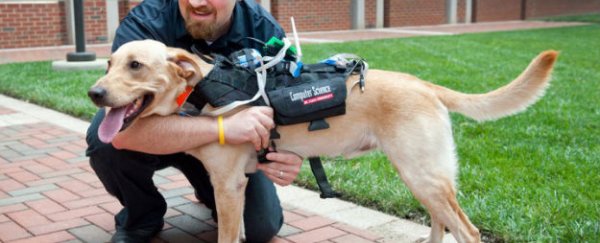Scientists in the US have invented a new technology that can help you communicate with your dog, and they hope to make it available to everyone from rescue and service dog handlers to owners interested in more effectively training their pets.
Developed by a team of engineers from North Carolina State University, a new wearable device is set to close the gap between humans and their canine companions by improving the way we communicate. Fitted with physiological and behavioural sensors, it has been designed to give owners a real-time picture of their dog's mental and emotional state, and allows them to more effectively send back signals and commands, even if their dog is out of sight.
"We've developed a platform for computer-mediated communication between humans and dogs that opens the door to new avenues for interpreting dogs' behavioural signals and sending them clear and unambiguous cues in return," said one of lead researchers, computer scientist David Roberts, in a press release. "We have a fully functional prototype, but we'll be refining the design as we explore more and more applications for the platform."
The device, which is about the size of a deck of cards, has been fitted into a wearable dog harness and works using two types of communication technologies. The first allows dogs to communicate with their owners - even when they're trying to hide their pain or stress - and the second allows owners to communicate with their dogs.
Because dogs primarily use body language cues to communicate their intentions and mood, the device uses special sensors that can identify what's going on with their posture at any given time, such as if the dog is sitting, standing, running or cowering. It also includes physiological sensors that can monitor the dog's heart rate and body temperature. All of this information is transmitted to another device that's held by the owner or handler, which can then be used to construct a real-time profile of the dog's physical well-being and emotional state.
The owner then uses their handheld device to communicate signals back to their dog using physical and vocal cues. "We've incorporated speakers and vibrating motors, called haptics, into the harness, which enable us to communicate with the dogs," says Roberts.
The team says the device can also be customised with additional capabilities depending on what the owner or handler wants to use it for. "For example, for search and rescue, we've added environmental sensors that can detect hazards such as gas leaks, as well as a camera and microphone for collecting additional information," one of the team, electrical and computer engineer Alper Bozkurt, said in the press release.
There will also be applications available specifically for guide dogs so their handlers can monitor their stress levels. This is super-important, because dogs - and guide dogs particularly - habitually try to hide their stress and pain from their owners.
Publishing their research in the journal IEEE Intelligent Systems, the researchers say they're now working on making the harness even smaller so it will be more attractive to regular dog owners for training exercises. They're also hoping to improve the device's physiological sensors so animal shelters and hospitals can keep a closer eye on the state of their dogs.
"This platform is an amazing tool, and we're excited about using it to improve the bond between dogs and their humans," said one of the team, Barbara Sherman, a clinical professor of animal behaviour at the NC State College of Veterinary Medicine.
It's not quite this, but science will get there eventually, right?

Source: North Carolina State University
